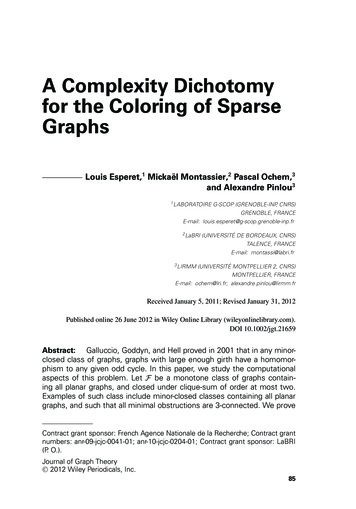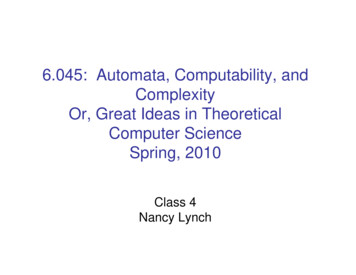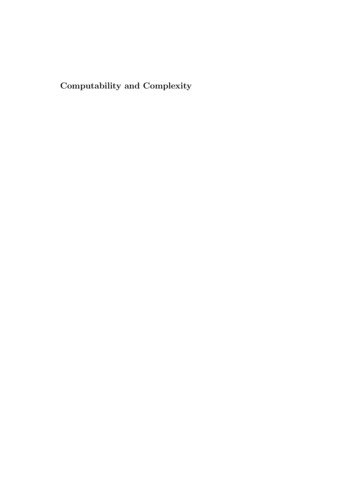
Transcription
A Complexity Dichotomyfor the Coloring of SparseGraphsLouis Esperet,1 Mickaël Montassier,2 Pascal Ochem,3and Alexandre Pinlou31 LABORATOIREG-SCOP (GRENOBLE-INP, CNRS)GRENOBLE, FRANCEE-mail: louis.esperet@g-scop.grenoble-inp.fr2 LaBRI(UNIVERSITÉ DE BORDEAUX, CNRS)TALENCE, FRANCEE-mail: montassi@labri.fr3 LIRMM(UNIVERSITÉ MONTPELLIER 2, CNRS)MONTPELLIER, FRANCEE-mail: ochem@lri.fr; alexandre.pinlou@lirmm.frReceived January 5, 2011; Revised January 31, 2012Published online 26 June 2012 in Wiley Online Library (wileyonlinelibrary.com).DOI 10.1002/jgt.21659Abstract: Galluccio, Goddyn, and Hell proved in 2001 that in any minorclosed class of graphs, graphs with large enough girth have a homomorphism to any given odd cycle. In this paper, we study the computationalaspects of this problem. Let F be a monotone class of graphs containing all planar graphs, and closed under clique-sum of order at most two.Examples of such class include minor-closed classes containing all planargraphs, and such that all minimal obstructions are 3-connected. We proveContract grant sponsor: French Agence Nationale de la Recherche; Contract grantnumbers: anr-09-jcjc-0041-01; anr-10-jcjc-0204-01; Contract grant sponsor: LaBRI(P. O.).Journal of Graph Theory C 2012 Wiley Periodicals, Inc.85
86JOURNAL OF GRAPH THEORYthat for any k and g, either every graph of girth at least g in F has a homomorphism to C2k 1 , or deciding whether a graph of girth g in F hasa homomorphism to C2k 1 is NP-complete. We also show that the samedichotomy occurs when considering 3-colorability or acyclic 3-colorabilityof graphs under various notions of density that are related to a questionof Havel (On a conjecture of Grünbaum, J Combin Theory Ser B 7 (1969),184–186) and a conjecture of Steinberg (The state of the three color problem, Quo Vadis, Graph theory?, Ann Discrete Math 55 (1993), 211–248)about the 3-colorability of sparse planar graphs. C 2012 Wiley Periodicals, Inc. J. GraphTheory 73: 85–102, 2013Keywords: homomorphism; complexity; sparse graphs1. INTRODUCTIONJaeger conjectured in 1988 [23] that for any k 1, the edges of any 4k-edge-connectedgraph can be oriented in the such way that for each vertex v, d (v) d (v) (mod 2k 1), where d (v) and d (v) denote the in- and out-degree of the vertex v. This conjectureis equivalent to Tutte’s 3-flow conjecture [36] for k 1 and implies Tutte’s 5-flowconjecture [35] for k 2. Restricted to planar graphs, Jaeger’s conjecture is equivalentto the following statement.Conjecture 1 (Jaeger [23]). For any k 1, every planar graph of girth at least 4k hasa homomorphism to C2k 1 .The case k 1 is equivalent to the fact that triangle-free planar graphs are 3-colorable,proved by Grötzsch in 1959 [19], and the remaining cases are open. This result ofGrötzsch led several researchers to investigate other (simple) sufficient conditions for aplanar graph to be 3-colorable. The following question and conjecture are two differentapproaches in this direction.Problem 1 (Havel [20]). Is there a constant i such that every planar graph withouttriangles at distance less than i apart is 3-colorable?Conjecture 2 (Steinberg [33]). Every planar graph without cycles of length four andfive is 3-colorable.While a positive answer to Havel’s problem was recently announced [13] (with avery large constant), Steinberg’s conjecture is still open. Erdős suggested the followingrelaxation of this conjecture: Does there exist a constant C such that the absence in aplanar graph of cycles of length 4 to C guarantees its 3-colorability? Abbott and Zhou[1] proved in 1991 that such a C exists and C 11. This result was then sequentiallyimproved [3], [4], [32], [31], until Borodin et al. proved in 2005 that every planar graphwithout cycles of length 4–7 is 3-colorable [5].All these problems have the same flavor: they suggest that for various types of coloring,every planar graph with sufficiently low density can be colored. Here, density should beunderstood as a broad notion, depending highly on the problem considered (and whichdoes not necessarily coincide with the technical definition of density). For instance, inthe case of Havel’s problem, the density would be correlated with the minimum distancebetween two triangles: the larger the distance, the lower the density.Journal of Graph Theory DOI 10.1002/jgt
A COMPLEXITY DICHOTOMY FOR THE COLORING OF SPARSE GRAPHS87Consider the following problem: does a graph G with maximum degree at most admita proper k-coloring? If k 1, then the problem is NP-complete; if k , then theproblem can be solved in polynomial time using Brooks Theorem (but the answer is notalways positive); and if k 1, then the answer is always positive. Our aim in thispaper is to prove that in each of the problems mentioned above (Havel, Steinberg, Jaeger,and a couple of others), this typically does not happen: the density threshold below whichevery planar graph becomes colorable is also a complexity threshold. We will show thatin each of the questions we consider, by decreasing the density the decision problemdrops directly from NP-complete to true always.As was pointed out by a referee, this kind of complexity jump appears in differentcontexts. Let (k, s)-SAT denote the Boolean satisfiability problem restricted to instanceswith exactly k variables per clause, and at most s occurrences per variable. Tovey [34]proved that (3, 4)-SAT is NP-complete, while (3, 3)-SAT is trivial (every instance issatisfiable). This was generalized by Kratochvı́l, Savický, and Tuza [25], who proved theexistence of a function f (of exponential order) such that for any k 3, (k, f (k) 1)SAT is NP-complete, while (k, f (k))-SAT is trivial. The reader is referred to [17] for amore detailed discussion about these results, together with the precise asymptotics for thefunction f (which is closely related to functions appearing in the Lovász Local Lemma).Structure of the PaperIn Section 3, we consider the 3-Color Problem. Using the main result of [13], we provethat there exists an integer d 4 such that every planar graph without triangles atdistance less than d is 3-colorable, but deciding whether a planar graph without trianglesat distance less than d 1 is 3-colorable is NP-complete. We also show, using [5], thatthere exists an integer i [5, 7] such that every planar graph without cycles of length4 to i is 3-colorable, but deciding whether a planar graph without cycles of length 4 toi 1 is 3-colorable is NP-complete (if Conjecture 2 is true, then i is precisely 5). Thereductions in the proofs of these two results are fairly easy, and can be considered as anintroduction to the reductions of the next sections.In Section 4, we consider (1, 0)-coloring of planar graphs. A graph is (1, 0)-colorableif its vertex set can be partitioned into a stable set and a set inducing a graph withmaximum degree at most 1. Glebov and Zambalaeva proved that every planar graphwith girth at least 16 is (1, 0)-colorable [18]. The value 16 was later decreased to 14by Borodin and Ivanova [6], and very recently to 12 by Borodin and Kostochka [9]. Weprove that for any integers d 3 and g 6, either every planar graph of girth at least gand maximum degree at most d is (1, 0)-colorable, or deciding whether a planar graphof girth at least g and maximum degree at most d is (1, 0)-colorable is NP-complete. Wethen improve some known constructions of non-(1, 0)-colorable sparse planar graphs.In Section 5, we study the acyclic coloring of planar graphs. A graph is acyclicallyk-colorable if it admits a proper k-coloring in which every cycle contains at least threecolors. A celebrated result of Borodin is that planar graphs are acyclically 5-colorable.He also proved that planar graphs with girth at least seven are 3-colorable [11]. Usingthis result, we show that there exists g [5, 7], such that every planar graph of girth atleast g is acyclically 3-colorable, but deciding whether a planar graph of girth at leastg 1 is acyclically 3-colorable is NP-complete.In Section 6, we investigate homomophisms to odd cycles. A homomorphism from agraph G to a graph H is a mapping h : V (G) V (H ) that preserves the edges, that is,Journal of Graph Theory DOI 10.1002/jgt
88JOURNAL OF GRAPH THEORYif uv is an edge of G, then h(u)h(v) is an edge of H. Using [10], we show that for everyk 2 there exists an integer g g(k), with 4k g 13 (20k 2), such that every planargraph of girth at least g has a homomorphism to C2k 1 , but determining whether a planargraph of girth g 1 has a homomorphism to C2k 1 is NP-complete. If Conjecture 1 istrue, then g(k) 4k.For the sake of clarity, all the results mentioned above are stated in the context ofplanar graphs. We will indeed prove that the dichotomy results still hold if instead ofplanar graphs we consider any monotone family F containing all planar graphs, andclosed under small clique-sum. As will be proved in the next section, examples of suchclasses include Kn -minor free graphs (n 5), graphs with no subdivision of Kn (n 5),and graphs with Colin de Verdière parameter at most k, for some k 3 (for instance,linklessly embeddable graphs).2. NICE CLASSESFor k 0, a graph obtained from the disjoint union of two graphs G1 and G2 by identifyinga k-clique of G1 with a k-clique of G2 is called a k-clique-sum of G1 and G2 . A smallclique-sum is a k-clique-sum with 0 k 2.A class of graphs containing all planar graphs is nice if it is closed under subgraphsand small clique-sums. The purpose of this section is to identify several important graphclasses fitting this description. It is easy to remark that for any k 4, the class of graphswith chromatic number at most k is nice (using the 4-Color Theorem, such a class containsall planar graphs). Similarly, using a famous result of Borodin, it follows that for anyk 5, the class of graphs with acyclic chromatic number at most k is a nice class.One of our main motivations is the result of Galluccio et al. [15] stating that in minorclosed families, high-girth graphs are almost bipartite. Hence, it is crucial to understandwhich minor-closed classes are nice.Lemma 1. A minor-closed class F containing all planar graphs is nice if and only ifall minimal forbidden minors of F are 3-connected.Proof. Assume first that all minimal forbidden minors of F are 3-connected, and letG1 , G2 F be such that a small clique-sum G of G1 and G2 is not in F . Consider aminor-minimal minor H of G that is not in F . Since G1 , G2 F , H is neither a minor ofG1 , nor a minor of G2 . Hence, H is not 3-connected, a contradiction.Assume now that F is nice. Let H be a minor-minimal graph such that H F . If Hcontains a clique-cutset of size at most two (in particular, H can be disconnected), then itis a small clique-sum of graphs from F (since H is minor-minimal), so H must be in F , acontradiction. So H contains no clique-cutset of size at most two, which implies that H is2-connected. Assume now that H contains two nonadjacent vertices u, v whose removaldisconnects H, and let H1 , . . . , Hk be the graphs induced by each component togetherwith u and v. Observe that H uv is the clique-sum of the graphs (Hi uv)1 i k on aclique of size two, and all the Hi s are minors of H. Since H is minor-minimal, all theHi s are in F and then H uv and H are also in F , a contradiction. It follows that H is3-connected. A minor-monotone graph invariant, usually denoted by μ, was introduced by Colinde Verdière in 1990 [12]. It relates to the maximal multiplicity of the second largestJournal of Graph Theory DOI 10.1002/jgt
A COMPLEXITY DICHOTOMY FOR THE COLORING OF SPARSE GRAPHS89FIGURE 1. An example of construction of G H (u, v ).eigenvalue of the adjacency matrix of a graph, in which the diagonal entries can take anypositive value and the entries corresponding to edges can take any nonnegative values(a technical assumption, called the Strong Arnold Property, has to be added to avoiddegenerate cases, but we omit the details). For a graph invariant f and an integer , letF ( f , ) be the set of graphs G with f (G) . It was proved by Colin de Verdière thatF (μ, 1) is the set of linear forests, F (μ, 2) is the set of outerplanar graphs, and F (μ, 3)is the set of planar graphs. It follows from [27] and [30] that μ(G) 4 if and only if Gis linklessly embeddable in R3 . A direct consequence of a result of van der Holst et al.[22] is that for any 3, F (μ, ) is closed under small clique-sums. Since F (μ, 3) isthe set of planar graphs, we have that for any 3, F (μ, ) is a nice class.Following the introduction of Colin de Verdière’s parameter, van der Holst et al. [21]defined a new minor-monotone parameter, called λ, and proved that λ is preserved by theclique-sum operation. They also proved that F (λ, 1) is the set of forests, F (λ, 2) is theset of K4 -minor free graphs, and F (λ, 3) is the set of graphs that can be obtained fromplanar graphs by taking clique-sums and subgraphs. As previously, this shows that for any 3, the class F (λ, ) is a nice class. The definition of λ was then extended by Edmondset al. [14] to a new minor-monotone graph parameter λ , satisfying λ (G) λ(G) for anygraph G, and having the same properties as the properties of λ mentioned above. It is notknown whether there exists a graph G such that λ (G) λ(G), so these two parametersmight very well be equal. Anyway, again, we have that for any 3, the class F (λ , )is a nice class.Observe that the proof of Lemma 1 is still valid if minor is replaced by topologicalminor in the statement of the lemma. Hence, for any n 5, the class of graphs with nosubdivision of Kn is nice.3. THE 3-COLOR PROBLEMFor two graphs G and H(u, v), where u and v are two distinct vertices of H(u, v), wedenote by G H(u, v) a graph constructed as follows: For every vertex x of G, we takedG (x) 1 copies H1x (u, v), . . . , HdxG (x) 1 (u, v) of H(u, v) and identify the vertex v ofxHix (u, v) with the vertex u of Hi 1for 1 i dG (x) 2. The vertices u of Hix (u, v) for1 i dG (x) 1 together with the vertex v of HdxG (x) 1 (u, v) are called the duplicatesof x. For every edge xy in G, we add an edge between one duplicate of x and one duplicateof y. An example of construction of G H(u, v) is depicted in Figure 1. By the definitionJournal of Graph Theory DOI 10.1002/jgt
90JOURNAL OF GRAPH THEORYof a nice class, if G is planar and H(u, v) uv is in a nice class F , then we can chooseG H(u, v) to be also in F .For an integer i 4, let Ci denote the class of graphs with no cycle of length 4 to i.Theorem 1. For every nice class F and integer i 4, either every graph in F Ci is3-colorable, or deciding whether a graph in F Ci is 3-colorable is NP-complete.Proof. Suppose there exist non-3-colorable graphs in F Ci , and consider such agraph H that is minimal with respect to the number of edges. Let H (u, v) be thegraph obtained from H by removing the edge uv. The graph H (u, v) is thus 3-colorable.Moreover, every 3-coloring of H (u, v) is such that u and v have the same color, otherwiseH would be 3-colorable.We take i/3 copies (Ht (u, v))1 t of H (u, v) and identify the vertex v of Ht (u, v) with the vertex u of Ht 1(u, v) for every 1 t 1. We thus obtain a graphH(u, v) having the same property as H (u, v), except that u and v are now at distanceat least i/3 apart. Note that H(u, v) uv F , since this graph can be obtained froma cycle (of length 1) by replacing precisely edges by copies of H (u, v), in otherwords we start with a planar graph, make clique-sums with H , and then remove edges, so the obtained graph is still in F .We prove the NP-completeness using a reduction from PLANAR 3-COLORABILITY,that is, the problem of deciding whether a planar graph is 3-colorable, which is NPcomplete [16]. Given an instance G of PLANAR 3-COLORABILITY, we construct a graphG G H(u, v) F Ci .Notice that G can be chosen to be in F , since H(u, v) uv F . Moreover, G hasno cycle of length 4 to i: by the definition of H(u, v), the vertices u and v are at distanceat least i/3 apart, so any cycle in G originating from a cycle in G must have length atleast 3 i/3 3 i 1. In a 3-coloring of G , all the duplicates of a vertex of G mustget the same color, so G is 3-colorable if and only if G is 3-colorable. Recall that Borodin et al. [5] proved that every planar graph in C7 is 3-colorable.Moreover, there exist planar graphs in C4 that are not 3-colorable [33]. We can thendeduce the following corollary.Corollary 1. There exists an integer i [5, 7] such that every planar graph in Ci is3-colorable, but deciding whether a planar graph in Ci 1 is 3-colorable is NP-complete.Let i be an integer and let Ti denote the class of graphs with no triangles at distanceless than i apart.Theorem 2. For every nice class F and integer i, either every graph in F Ti is3-colorable, or deciding whether a graph in F Ti is 3-colorable is NP-complete.Proof. We use the same construction and reduction as in the proof of Theorem 1.Suppose that H is a non-3-colorable graph in F Ti that is minimal with respect to thenumber of edges. Let uv be an edge in H that is contained in a triangle if H does containa triangle and any edge otherwise. The graph H(u, v) is obtained from H by removingthe edge uv. Notice that u and v are at distance at least i from all the triangles in H(u, v).Hence, the graph G G H(u, v) F has no triangle at distance less than i apart. Aspreviously, G is 3-colorable if and only if G is 3-colorable. Journal of Graph Theory DOI 10.1002/jgt
A COMPLEXITY DICHOTOMY FOR THE COLORING OF SPARSE GRAPHS91FIGURE 2. The graph H (t ) forcing color 10 on the vertex t of degree 1.Using a construction of Aksionov and Mel’nikov [2] and the main result of [13],Theorem 2 has the following corollary.Corollary 2. There exists an integer i 4 such that any planar graph in Ti is 3-colorable,but deciding whether a planar graph in Ti 1 is 3-colorable is NP-complete.4. (1, 0)-COLORING OF GRAPHSThe girth of a graph G is the length of a shortest cycle of G. Let Cg,d denote the class ofplanar graphs with girth at least g and maximum degree at most d.Borodin and Ivanova [6] proved that every planar graph with girth at least 14 is(1, 0)-colorable. In this section we prove the following theorem.Theorem 3. Let g 6 and d 3 be integers. Either every graph in Cg,d is (1, 0)colorable, or deciding whether a graph in Cg,d is (1, 0)-colorable is NP-complete.Proof. Consider a (1, 0)-coloring c of a graph. For convenience, we will say that avertex v has the color 10 if c(v) 1 and none of its neighbors is colored with 1; a vertexhas the color 11 if itself and one of its neighbors are colored with 1.Suppose there exists a graph G with girth at least g 6 that is not (1, 0)-colorable,and take such a graph G with the minimum number of edges. One can easily observethat G has minimum degree at least 2. It is well known that planar graphs with girth atleast six are 2-degenerate, so G contains a vertex u of degree 2. Assume that u is adjacentto the vertices v and w. By minimality of G, G \ u admits a (1, 0)-coloring, and in anysuch coloring φ we have either φ(v) 0 and φ(w) 11 or the converse. Let H(t ) bethe graph obtained from G as follows: we add a vertex t adjacent to u only and then wesubdivide once the edges uv, uw and ut (see Fig. 2). By the remark above H(t ) has a(1, 0)-coloring and in any such coloring φ we have φ(u) 11 and φ(t ) 10 .An instance of 3-SAT is said planar if its variable-clause graph is planar. We reduceour problem from PLANAR 3-SAT, which was proved to be NP-complete by Lichtenstein[26]. Consider an instance I of PLANAR 3-SAT. We construct a graph H I and prove thatit is (1, 0)-colorable if and only if I is satisfiable. To each variable x of I we associate thegraph Hx depicted in Fi
Published online 26 June 2012 in Wiley Online Library (wileyonlinelibrary.com). DOI 10.1002/jgt.21659 Abstract: Galluccio, Goddyn, and Hell proved in 2001 that in any minor-closed class of graphs, graphs with large enough girth have a homomor-phism to any given odd cycle. In this paper, we study the computational aspects of this problem.











